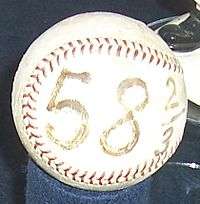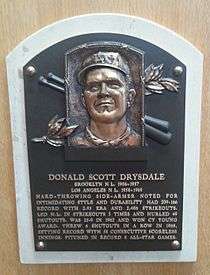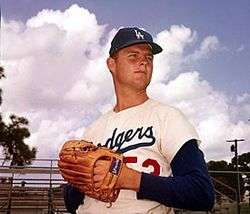Don Drysdale
| Don Drysdale | |||
|---|---|---|---|
|
Drysdale in 1959 | |||
| Pitcher | |||
|
Born: July 23, 1936 Van Nuys, California, United States | |||
|
Died: July 3, 1993 (aged 56) Montreal, Quebec, Canada | |||
| |||
| MLB debut | |||
| April 17, 1956, for the Brooklyn Dodgers | |||
| Last MLB appearance | |||
| August 5, 1969, for the Los Angeles Dodgers | |||
| MLB statistics | |||
| Win–loss record | 209–166 | ||
| Earned run average | 2.95 | ||
| Strikeouts | 2,486 | ||
| Teams | |||
| Career highlights and awards | |||
| |||
| Member of the National | |||
| Inducted | 1984 | ||
| Vote | 78.41% (tenth ballot) | ||
Donald Scott "Don" Drysdale (July 23, 1936 – July 3, 1993) was an American professional baseball player and television sports commentator. He played as a right-handed pitcher for the Los Angeles Dodgers for his entire career in Major League Baseball. Inducted into the Hall of Fame in 1984, Drysdale was one of the most dominant pitchers of the late 1950s and early to mid 1960s.[1] Standing 6 ft 5 in (1.96 m) tall, he was an intimidating presence on the pitcher's mound and, was not afraid to throw pitches close to batters in order to keep them off balance.[1] Drysdale won the 1962 Cy Young Award and is known for setting a Major League Baseball record by pitching 58 2⁄3 consecutive scoreless innings in 1968.[1][2] After his playing career, he became a radio and television broadcaster.[3]
Early life
Drysdale was born in Van Nuys, Los Angeles and attended Van Nuys High School, where one of his classmates was actor Robert Redford.[4]
Playing career
| | |
| Donald Drysdale's number 53 was retired by the Los Angeles Dodgers in 1984. |
Pitching for the Brooklyn and Los Angeles Dodgers, he teamed with Sandy Koufax during the late 1950s and early and middle 1960s to form one of the most dominating pitching duos in history. Nicknamed "Big D" by fans, Drysdale used brushback pitches and a sidearm fastball to intimidate batters,[3] similar to his fierce fellow Hall of Famer Bob Gibson. His 154 hit batsmen remains a modern National League record.
Drysdale was also a good hitter for a pitcher. In 14 seasons, he had 218 hits, including 29 home runs, and was occasionally used as a pinch-hitter, once even during the World Series.[5]

In 1962, Drysdale won 25 games and the Cy Young Award. In 1963, he struck out 251 batters and won Game 3 of the World Series at Los Angeles' Dodger Stadium over the Yankees, 1–0. In 1965, he was the Dodgers' only .300 hitter and tied his own National League record for pitchers with seven home runs. That year, he also won 23 games and helped the Dodgers to their third World Championship in Los Angeles. In 1968, he set Major League records with six consecutive shutouts and 58 2⁄3 consecutive scoreless innings; the latter record was broken by fellow Dodger Orel Hershiser 20 years later. He ended his career with 209 wins, 2,486 strikeouts, 167 complete games and 49 shutouts. He was inducted into the Baseball Hall of Fame in 1984, and had his number 53 retired at Dodger Stadium on July 1, 1984. He was also the last player on the Dodgers who had played for Brooklyn.
He won three NL Player of the Month awards: June 1959 (6-0 record, 1.71 earned run average, 51 strikeouts), July 1960 (6-0 record, 2.00 earned run average, 48 strikeouts), and May 1968 (5-1 record, 0.53 earned run average, 45 strikeouts, with 5 consecutive shutouts to begin his scoreless inning streak, which was carried into June).
In 1965, Sandy Koufax declined to pitch the first game of the World Series because it was on Yom Kippur, a Jewish holy day. Drysdale pitched for the Dodgers instead of Koufax, and gave up seven runs in 2 2/3 innings. When Walter Alston, the manager, came to the mound to remove him from the game, Drysdale said, "I bet right now you wish I was Jewish, too." The Dodgers lost to the Minnesota Twins, 8-2.
Drysdale and Koufax took part in a famous salary holdout together in the spring of 1966, with both finally signing contracts just before the season opened. Those contracts made them the first pitchers to earn more than $100,000 a year.[3] This holdout was the beginning of collective bargaining in baseball.
Broadcasting career
A chronically sore shoulder forced Drysdale to retire during the 1969 season. The next year he started a broadcasting career that continued for the rest of his life: first for the Montreal Expos (1970–1971), then the Texas Rangers (1972), California Angels (1973–1979, 1981), Chicago White Sox (1982–1987), NBC (1977), ABC (1978[6]–1986), and finally back in Los Angeles with the Dodgers (from 1988 until his death in 1993). He also worked with his Angels' partner Dick Enberg on Los Angeles Rams football broadcasts from 1973–1976.
While at ABC Sports, Drysdale not only did baseball telecasts, but also regional college football games as well as Superstars and Wide World of Sports. In 1979, Drysdale covered the World Series Trophy presentation ceremonies for ABC. On October 11, 1980, Keith Jackson called an Oklahoma–Texas college football game for ABC in the afternoon, then flew to Houston to call Game 4 of the NLCS between the Houston Astros and Philadelphia Phillies. In the meantime, Drysdale filled in for Jackson on play-by-play for the early innings.
In 1984, Drysdale called play-by-play (alongside Reggie Jackson and Earl Weaver) for the National League Championship Series between the San Diego Padres and Chicago Cubs. On October 6, 1984 at San Diego's Jack Murphy Stadium, Game 4 of the NLCS ended when Padres first baseman Steve Garvey hit a two run home run off Lee Smith. Drysdale on the call:
| “ | Deep right field, way back. Cotto going back to the wall...it's gone! Home run Garvey! And there will be tomorrow! | ” |
The Padres, who rallied from a 2–0 deficit in the best-of-five series against the Cubs won the decisive Game 5 the next day (thus, winning their first ever National League pennant).
In his last ABC assignment, Drysdale interviewed the winners in the Boston Red Sox's clubhouse following Game 7 of the 1986 American League Championship Series against the California Angels.
While broadcasting for the White Sox, Drysdale generated some controversy while covering a heated argument between an umpire and Sox manager Tony La Russa. LaRussa pulled up the third base bag and hurled it into the outfield, to the approval of the Comiskey Park crowd, and ensuring his ejection. Drysdale remarked, "Go get 'em, Dago!"
For the Sox, Drysdale broadcast Tom Seaver's 300th victory, against the host New York Yankees in 1985. His post-game interview with Seaver was carried live by both the Sox' network and the Yankees' longtime flagship television station WPIX.
1987
Drysdale hosted a nationally syndicated radio show called Radio Baseball Cards. 162 episodes were produced with stories and anecdotes told by current and former Major League Baseball players. The highlight of the series were numerous episodes dedicated to the memory and impact of Jackie Robinson as told by teammates, opponents and admirers. Radio Baseball Cards aired on 38 stations, including WNBC New York, KSFO San Francisco and WEEI Boston, as a pre-game show. A collector's edition of the program was re-released in 2007 as a podcast.[7]
1988
Drysdale conducted all of the National League player interviews for the Baseball Talk series in 1988 (Joe Torre did the same for the American League).
On September 28, 1988, fellow Dodger Orel Hershiser surpassed Drysdale when Hershiser finished the season with a record 59 consecutive scoreless innings pitched. In his final start of the year, Hershiser needed to pitch 10 shutout innings to set the mark – meaning not only that he would have to prevent the San Diego Padres from scoring, but that his own team would also need to fail to score in order to ensure extra innings. The Dodgers' anemic offense obliged, and Hershiser pitched the first 10 innings of a scoreless tie, with the Padres eventually prevailing 2–1 in 16 innings. Hershiser almost did not pitch in the 10th inning, in deference to Drysdale, but was convinced to take the mound and try to break the record. When Hershiser broke Drysdale's record, Drysdale went to hug him, and said, "Oh, I'll tell ya, congratulations... And at least you kept it in the family."
Drysdale also called Kirk Gibson's walk-off home run in Game 1 of the 1988 World Series[8] for the Dodgers Radio Network:
| “ | Well, the crowd is on its feet and if there was ever a preface to 'Casey at the Bat' it would have to be the ninth inning. Two out. The tying run aboard, the winning run at the plate, and Kirk Gibson, standing at the plate. Eckersley working out of the stretch, here's the three-two pitch...and a drive hit to right field (losing voice) WAY BACK! THIS BALL IS GONE! (After 2 minutes of crowd noise) This crowd will not stop! They can't believe the ending! And this time, Mighty Casey did NOT strike out!!!! | ” |
Personal life

Drysdale married Ginger Dubberly in 1958, with whom he had a daughter, Kelly. They divorced in 1982. On November 1, 1986, he married basketball player Ann Meyers, who took the name Ann Meyers-Drysdale. Drysdale and Meyers had three children together: Don Junior ("DJ") (son), Darren (son), and Drew (daughter).
In 1990, Drysdale published his autobiography, Once a Bum, Always a Dodger.
Death
Drysdale was 56 when he died of a heart attack in room 2518 of Le Centre Sheraton in Montreal, Quebec, on July 3, 1993.[3][9] Radio station employees were sent to look for him when he did not appear for the bus ride to Olympic Stadium, where the Dodgers were scheduled to play the Montreal Expos. Hotel staff entered his room and found him face down, near his bed. The coroner estimated that he had been dead for 18 hours.
Drysdale's broadcasting colleague Vin Scully, who was instructed not to say anything on the air until Drysdale's family was notified, announced the news of his death by saying, "Never have I been asked to make an announcement that hurts me as much as this one. And I say it to you as best I can with a broken heart."[10] Fellow broadcaster Ross Porter told his radio audience, "I just don't believe it, folks." While this was going on, word reached Drysdale's former White Sox colleague Ken Harrelson as he was calling that evening's game against the Baltimore Orioles; an emotional Harrelson had trouble relaying the news to the viewing audience. Drysdale was replaced by Rick Monday in the broadcast booth.
Among the personal belongings found in Drysdale's hotel room was a cassette tape of Robert F. Kennedy's victory speech after the 1968 California Democratic presidential primary, a speech given only moments before Senator Kennedy's assassination. In the speech, Kennedy had noted, to the cheers of the crowd, that Drysdale had pitched his sixth straight shutout that evening. Drysdale had apparently carried the tape with him wherever he went since Kennedy's murder.[11]
Drysdale's body was cremated at Forest Lawn Memorial Park Cemetery in Glendale, California.
Media
Television
Drysdale was a popular guest star in several television programs:
- The Beverly Hillbillies: The Clampetts & The Dodgers. Don Drysdale & Leo Durocher are guest stars in this episode when Jed & Jethro play golf with the Dodgers and Leo Durocher finds out Jed and Jethro are good baseball prospects. April 10, 1963.
- The Greatest American Hero (episode "The Two Hundred Mile an Hour Fastball", which was first broadcast on November 4, 1981 as a broadcaster for the California Stars.[12]
- The Brady Bunch episode "The Dropout", which was first broadcast on September 25, 1970.
- Our Man Higgins episode "Who's on First?" (May 8, 1963).
- The Donna Reed Show episodes "The Man in the Mask", first broadcast in 1962; "All Those Dreams", first broadcast in 1963; and "Play Ball" and "My Son the Catcher", both first broadcast in 1964. In all four episodes Drysdale played himself, and in "All Those Dreams" he appeared with first wife, Ginger, and daughter Kelly.
- Leave It to Beaver episode "Long Distance Call", which was first broadcast on June 16, 1962.[13]
- The Rifleman episode "Skull", which was first broadcast on January 1, 1962.
- The Millionaire episode "Millionaire Larry Maxwell", which was first broadcast on March 1, 1960.
- With his first wife, Ginger, on February 26, 1959 edition of You Bet Your Life with host Groucho Marx.[14] The episode was released on the 2006 DVD "Groucho Marx: You Bet Your Life – 14 Classic Episodes".
- In 1959, Drysdale appeared as a mystery challenger on the TV panel show To Tell the Truth.
- The Flying Nun episode "The Big Game", 1st episode of the 3rd season, aired September 17, 1969.[15]
Film
The number "53" used for Disney's Herbie the Love Bug was inspired by Drysdale.[16]
Drysdale also appeared as himself (pitching) in the 1962 thriller, Experiment in Terror, starring Glenn Ford and Lee Remick.
See also
- List of Major League Baseball all-time leaders in home runs by pitchers
- List of Major League Baseball players who spent their entire career with one franchise
- List of Major League Baseball individual streaks
- List of Major League Baseball single-inning strikeout leaders
- List of Major League Baseball career wins leaders
- List of Major League Baseball annual strikeout leaders
- List of Major League Baseball annual wins leaders
- List of Major League Baseball career hit batsmen leaders
- List of Major League Baseball career strikeout leaders
- Major League Baseball titles leaders
References
- 1 2 3 "Don Drysdale at the Baseball Hall of Fame". baseballhall.org. Retrieved January 9, 2016.
- ↑ "1968: Year of the Pitcher". thisgreatgame.com. Retrieved January 9, 2016.
- 1 2 3 4 Lyons, Richard D. (July 4, 1993). "Don Drysdale Is Dead at Age 56; Hall of Fame Pitcher for Dodgers". New York Times. Retrieved 26 December 2015.
- ↑ Henson, Steve (July 12, 1993). "He Never Left Van Nuys High". Los Angeles Times. Retrieved February 28, 2011.
- ↑ Chass, Murray (October 27, 1991). "World Series Notebook – Kaat Knows Something About Pitchers at the Plate". New York Times. Retrieved 26 December 2015.
- ↑ "History of #1 analyst demotions". Classic Sports TV and Media. February 18, 2013. Retrieved April 13, 2013.
- ↑ Smarter Podcasts – Home
- ↑ Don Drysdale's call of Gibson home run on YouTube
- ↑ http://articles.latimes.com/1997/aug/08/sports/sp-20491
- ↑ Don Drysdale Is Dead on YouTube
- ↑ Dodgers treated to screening of 'Bobby'
- ↑ The Greatest American Hero: The Two-Hundred-Mile-an-Hour Fastball TV.com
- ↑ TV.com
- ↑ https://www.youtube.com/watch?v=m4OPrgXfSoc&list=PLiysj-EKbPPqnbL63xLO5G27jkP0_Cr3P&index=29
- ↑
- ↑ Herbie The Love Bug Clip from Disney documentary Age of Believing Dean Jones Walt Disney on YouTube
External links
- Career statistics and player information from Baseball-Reference, or Baseball-Reference (Minors)
- Don Drysdale at the Baseball Hall of Fame
- dondrysdale.com Official web site
- Don Drysdale at Find a Grave
- Branch Rickey's 1954 amateur scouting report on Drysdale, at the Library of Congress.
- Don Drysdale at the Internet Movie Database
| Accomplishments | ||||||||||||
|---|---|---|---|---|---|---|---|---|---|---|---|---|
|
